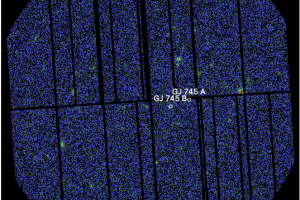
The corona is the outermost part of the atmosphere of the vast majority of stars, where the plasma is heated to millions of degrees by stellar magnetic activity. Since both the intensity and the topology of the stellar magnetic fields depend on the internal structure of stars, the study of coronal activity allows astronomers to better understand both the high-energy phenomena occurring in stars, and to probe the internal structure of stars and how it depends on stellar parameters and evolutionary phase. Due to the high temperature of coronal plasma, only X-ray observations can be used to study the complex phenomena occurring in stellar coronae.
M type stars (with an effective temperature ranging from 2350 to 3850 K) are extremely interesting subjects for the study of stellar magnetic activity for several reasons. First, they are the most common type of stars in the Universe. Second, their internal structure allows for the production of an intense and complex magnetic field. Lastly, they often host terrestrial planets. This is a quite important point since one of the stellar properties that can influence the habitability of planets is X-ray luminosity of the host stars, as these high-energy photons can impact the chemistry and physical properties of planetary atmospheres.
To study the coronal activity of M stars located near the Sun (within approximately 30 light years), a team led by the astronomer M. Caramazza (Eberhard-Karls Universität Tübingen) analyzed X-ray observations of 141 stars with spectral classes ranging from M0 to M4 within this proximity to the Sun. These stars were selected based on data provided by the Gaia satellite of the European Space Agency. X-ray data were collected from the satellites XMM/Newton, Rosat, and eRosita. The observed levels of X-ray emission in these stars were then compared with emissions observed from different types of solar corona structures, with the goal of understanding the dominant coronal structure in these stars.
The study revealed that the level of X-ray emission in these M stars varies by approximately three orders of magnitude, equivalent to a factor of around one thousand. The brightest stars in terms of X-ray emissions are those in the saturated regime, where the stellar X-ray emission does not depend on stellar rotation (which is one of the main factors determining the production of the stellar magnetic field). On the other hand, the faintest stars have an X-ray flux of approximately 10000 erg cm−2 s−1. This wide range of potential X-ray luminosities reflects the different coronal properties observed in these stars, with the brightest ones having coronae dominated by active regions (areas characterized by intense magnetic activity), while the faintest stars have coronae dominated by quiescent regions.
The lower end of the X-ray luminosity distribution of these stars is represented by the binary system GJ 745, consisting of two ancient stars with very low metallicity (which is the abundance of elements heavier than helium) and very weak magnetic activity. In the XMM/Newton observations analyzed in this study, the component GJ 745 A is not observed, while GJ 745 B is weakly detected thanks to a stellar flare (rapid phenomena resulting in an impulsive release of X-ray emission). The X-ray emission level in these two stars is comparable to that of a solar corona dominated by coronal holes. These are structures observed in the Sun, associated with very low magnetic activity and open magnetic field lines that allow the coronal plasma to escape into interplanetary space. The level of X-ray emission in these two stars is so low that it would not significantly affect the properties of the atmospheres of any planets they may host. The study is described in the paper titled “
Complete X-ray census of M dwarfs in the solar neighborhood. I. GJ 745 AB: Coronal-hole stars in the 10 pc sample“, recently published in Astronomy & Astrophysics. Among the coauthors is the astronomer S. Orlando from INAF – Astronomical Observatory of Palermo.
The figure (click here to visualize it entirely) shows the XMM/Newton image of the binary system GJ 745, with the positions of the two component marked.
Here it is possible to explore a 3M model of the corona of GJ 475 B, produced by the 3DMAP-VR team of INAF – Astronomical Observatory of Palermo.
Mario Giuseppe Guarcello ( follow mariospiegacose) ( mariospiegacose) ( follow mariospiegacose)
Follow the Astronomical Observatory of Palermo on Facebok and on Instagram
Subscribe the Youtube channel of the Astronomical Observatory of Palermo

